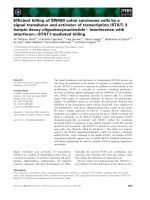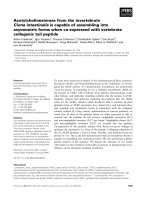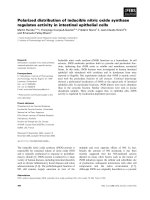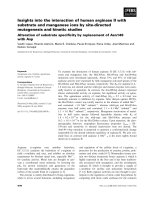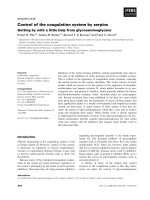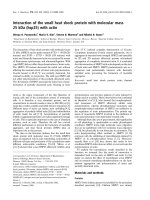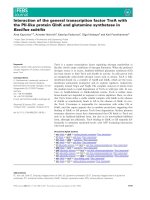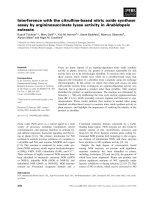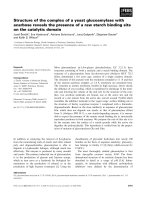Báo cáo khoa học: Interference with the citrulline-based nitric oxide synthase assay by argininosuccinate lyase activity in Arabidopsis extracts docx
Bạn đang xem bản rút gọn của tài liệu. Xem và tải ngay bản đầy đủ của tài liệu tại đây (732.19 KB, 8 trang )
Interference with the citrulline-based nitric oxide synthase
assay by argininosuccinate lyase activity in Arabidopsis
extracts
Rudolf Tischner
1,
*, Mary Galli
2,
*, Yair M. Heimer
3,
*, Sarah Bielefeld
1
, Mamoru Okamoto
2
,
Alyson Mack
2
and Nigel M. Crawford
2
1 Albrecht von Haller Institut fur Pflanzenwissenschaften, University of Gottingen, Germany
2 Section of Cell and Developmental Biology, Division of Biological Sciences, University of California at San Diego, La Jolla, CA, USA
3 Department of Dryland Biotechnologies, J. Blaustein Institute for Desert Research, Ben-Gurion University, Sede-Boker, Israel
Nitric oxide (NO) serves as a central signal in a wide
variety of processes, including vasodilation, neural
communication and immune function in animals [1],
and defense responses, hormonal signaling and flower-
ing in plants [2–6]. The primary mechanism for NO
synthesis in animals involves oxidation of l-arginine to
l-citrulline and NO, and requires NADPH and oxygen
[7–9]. This reaction is catalyzed by nitric oxide syn-
thase (NOS) enzymes, which require tetrahydrobiopter-
in (BH
4
), FMN, FAD, calmodulin (CaM), and Ca
2+
.
Three isoforms of highly conserved NOS enzymes have
been identified in mammals: neuronal NOS (nNOS
or NOS-I), inducible NOS (iNOS or NOS-II), and
endothelial NOS (eNOS or NOS-III). NOS enzymes
contain an N-terminal oxygenase domain and a
C-terminal reductase domain connected by a CaM-
binding hinge region. NOS enzymes are also found in
specific species of fish, invertebrates, protozoa and
fungi [10–12]. Even bacteria contain genes coding for
truncated NOS proteins with homology to the oxygen-
ase domain of mammalian NOS, and these enzymes
have nitration or NO synthesis activity [13–16].
Despite the high degree of conservation found
among NOS enzymes, no protein with significant
sequence similarity has been identified in plants,
including Arabidopsis [17] and rice [18], the genomes of
which have been sequenced. Plants can produce and
release significant amounts of NO, especially under
hypoxic conditions or during infection [2,3,19–27]. One
source of NO is nitrite, which can be converted to NO
Keywords
Arabidopsis; argininosuccinate lyase;
citrulline; nitric oxide
Correspondence
N. M. Crawford, Section of Cell and
Developmental Biology, Division of
Biological Sciences, University of California
at San Diego, La Jolla, CA 92093-0116, USA
Fax ⁄ Tel: +1 858 534 1637
E-mail:
*These authors contributed equally to this
work
(Received 23 February 2007, revised
24 May 2007, accepted 20 June 2007)
doi:10.1111/j.1742-4658.2007.05950.x
There are many reports of an arginine-dependent nitric oxide synthase
activity in plants; however, the gene(s) or protein(s) responsible for this
activity have yet to be convincingly identified. To measure nitric oxide syn-
thase activity, many studies have relied on a citrulline-based assay that
measures the formation of l-citrulline from l-arginine using ion exchange
chromatography. In this article, we report that when such assays are used
with protein extracts from Arabidopsis, an arginine-dependent activity was
observed, but it produced a product other than citrulline. TLC analysis
identified the product as argininosuccinate. The reaction was stimulated by
fumarate (> 500 lm), implicating the urea cycle enzyme argininosuccinate
lyase (EC 4.3.2.1), which reversibly converts arginine and fumarate to argi-
ninosuccinate. These results indicate that caution is needed when using
standard citrulline-based assays to measure nitric oxide synthase activity in
plant extracts, and highlight the importance of verifying the identity of the
product as citrulline.
Abbreviations
ADF, Arabidopsis-derived factor; ASL, argininosuccinate lyase; BH
4
, tetrahydrobiopterin; CaM, calmodulin; NO, nitric oxide; NOS, nitric oxide
synthase.
4238 FEBS Journal 274 (2007) 4238–4245 ª 2007 The Authors Journal compilation ª 2007 FEBS
by: (a) plant nitrate reductase [22,28–30]; (b) mito-
chondria [31–33]; and (c) nonenzymatic processes
[34,35]. There is also ample evidence from biochemical
and pharmacological data that an arginine-dependent
mechanism analogous to animal NOS reactions exists
in plants [26,36–43]; however, the identity of the argi-
nine-dependent activity in plants has yet to be conclu-
sively determined.
Some of the evidence supporting an arginine-depen-
dent mechanism in plants comes from commercially
available ‘NOS assay kits’ (citrulline-based assays) that
measure the conversion of arginine to citrulline using
ion exchange chromatography [44]. Radiolabeled argi-
nine is provided as a substrate, and is then separated
from reaction products by cation exchange chromato-
graphy. Positively charged arginine binds the ion
exchange resin but citrulline does not. The unbound
fraction, which is generally assumed to be citrulline, is
measured in a scintillation counter. Examples of the
use of this assay include the analysis of NOS activity
in aluminum-treated Hibiscus [45], in pea peroxisomes
[38], and in elicitor-treated Hypericum cells [46].
Although the assay is quick and sensitive, it does not
identify the product as citrulline; any arginine deriva-
tive that does not bind to the cation exchange resin
will give a signal. The discovery of a product from a
typical NOS reaction that is not citrulline was reported
in a mammalian system [47].
There have been several attempts to identify the
source responsible for arginine-dependent NOS activity
in plants. The most recent attempt, which identified
the gene AtNOS1 [42], has subsequently been chal-
lenged [48–50], leading to the proposal that the gene
be renamed AtNOA1 for nitric oxide-associated [48].
Thus, a renewed effort was made to determine the
source of arginine-dependent NOS activity in plants,
using crude protein extracts from Arabidopsis leaves.
By employing the citrulline-based NOS assay, an argi-
nine-dependent activity was discovered that was
strongly stimulated by an extract of low molecular
weight compounds from Arabidopsis leaves and pro-
duced argininosuccinate rather than citrulline. These
results identify a reaction that is catalyzed by an activ-
ity unrelated to NOS and that can interfere with or
mask authentic NOS activity.
Results and Discussion
As a first approach to search for NOS activity in Arabid-
opsis, the citrulline-based NOS assay was used to test
extracts from Arabidopsis leaves. Crude protein extracts
(supernatant from a 2 · 10
4
g centrifugation) were incu-
bated with [
14
C]arginine, NADPH and mammalian
NOS cofactors (BH
4
, FMN, FAD, Ca
2+
and CaM). At
the end of the reaction, unreacted arginine was removed
from the assay mixture with a cation exchange resin.
Radioactive material that did not bind the resin, pre-
sumably citrulline, was measured by scintillation count-
ing. The signal obtained from a complete reaction
(Fig. 1, lane 1) was up to 20 times higher than that from
the control, which was a complete reaction terminated
immediately after the addition of radiolabeled arginine.
To determine potential cofactor requirements for the
observed activity, leaf extracts were desalted using G-25
Sephadex to remove low molecular weight compounds.
The low molecular weight compounds retained by the
G-25 column were also collected by further elution of
the column as described in Experimental procedures.
Desalted protein extracts alone had greatly reduced
levels of activity (Fig. 1, lane 2), indicating that a low
molecular weight compound(s) from the extract was
necessary for activity. Adding back the low molecular
weight fraction from the G-25 column to the desalted
protein extract restored activity (Fig. 1, lane 3). We
named the low molecular weight fraction ADF, for
0
2000
4000
6000
8000
10000
12000
14000
16000
18000
delta cpm mg protein
-1
h
-1
12345
Fig. 1. Detection of arginine-dependent activity in Arabidopsis
extracts. Reactions measured the conversion of [
14
C]arginine to a
product that did not bind a cation exchange resin. The data are pre-
sented as delta c.p.m.Æmg
)1
proteinÆh
)1
, which refers to the c.p.m.
value of the test reaction minus the c.p.m. value from the control
reaction (reaction terminated immediately after the addition of
[
14
C]arginine). The average c.p.m. for the control reaction was
approximately 1800. Reactions were performed using the com-
plete, initial buffer containing NOS cofactors as described in Experi-
mental procedures. Reactions also contained the following
components: lane 1, crude protein extract from Arabidopsis leaves;
lane 2, desalted protein extract; lane 3, desalted protein extract
plus low molecular weight fraction (ADF); lane 4, same as lane 3
except that the desalted protein extract was boiled before the
assay; lane 5, same as lane 3 except that the ADF was boiled
before the assay. Data are averages from 10 reactions; error bars
indicate SDs.
R. Tischner et al. Argininosuccinate lyase and NOS assay
FEBS Journal 274 (2007) 4238–4245 ª 2007 The Authors Journal compilation ª 2007 FEBS 4239
Arabidopsis-derived factor. The stimulation of activity
by ADF was positively correlated with the amount of
ADF added (Fig. 2). Boiled protein extract showed very
little activity in the presence of ADF (Fig. 1, lane 4),
whereas boiled ADF (Fig. 1, lane 5) stimulated activ-
ity as much as untreated ADF (Fig. 1, lane 3) when
added to the desalted extract, indicating that ADF is
heat stable.
These results suggested that an arginine-dependent
activity was present in protein extracts of Arabidopsis
leaves, and that a low molecular weight molecule(s)
was required for this activity. To determine whether
this activity was similar to that of mammalian NOS
enzymes, two experiments were performed. First,
cofactors essential for NOS activity (BH
4
, FMN,
FAD, Ca
2+
and CaM) were omitted from the reac-
tion. Robust activity was still observed for crude pro-
tein extract and desalted protein extract to which ADF
was added (Fig. 3A, lanes 1–4). For these reactions,
partially purified ADF preparations were used (purifi-
cation involved boiling leaf extracts and then passing
them through two gel filtration columns and an anion
exchange column, as described in Experimental proce-
dures). We performed an additional experiment to test
for flavin-dependent activity, using diphenylene iodoni-
um (an inhibitor of flavoproteins including animal
NOS), and found no inhibition of the activity at con-
centrations of diphenylene iodonium up to 10 lm (data
not shown). Second, the products of the reaction were
analyzed by one-dimensional TLC followed by auto-
radiography. No citrulline was detected on the auto-
radiograms; instead, an unidentified compound was
observed as the major reaction product (Fig. 3B).
Together, these results showed that the reaction had
no requirement for known NOS cofactors and did not
produce the NOS coproduct citrulline, indicating that
it was not a typical NOS reaction.
To identify the unknown compound, the reaction
products were analyzed by two-dimensional TLC on
silica gel plates.
14
C-Labeled argininosuccinate was the
only radiolabeled product identified (Fig. 4). No radio-
labeled products comigrating with citrulline, ornithine,
urea, valine, hydroxyarginine, agmatine, spermine,
spermidine, putrescine or proline were detected (Fig. 4
and data not shown).
0 5 10 15 20
0
2000
4000
6000
8000
10000
12000
14000
16000
delta cpm mg protein
-1
h
-1
µL ADF
Fig. 2. Dependence of arginine-dependent reaction on ADF. Desalt-
ed protein extracts were incubated with [
14
C]arginine and increas-
ing amounts of partially purified ADF, and then assayed for activity
as described in Fig. 1. Data points are averages from five repli-
cates; error bars indicate SDs.
A
B
Fig. 3. The arginine-derived reaction product is not citrulline. Crude
protein extracts (lanes 1 and 2), desalted protein extracts (lanes 3
and 4), boiled extracts (lanes 5 and 6) and no extract (lane 7) were
assayed with [
14
C]arginine and 50 mM NaPO
4
(i.e. with no NOS co-
factors) in 50 lL as described in Experimental procedures. Partially
purified ADF (37 lg) was included in lanes 2, 4 and 6. Reaction
products (radioactive material that did not bind the cation exchange
column) were analyzed by scintillation counting (A) and TLC (B).
The TLC plate was developed with acetonitrile ⁄ ammonium hydrox-
ide ⁄ water (4 : 1 : 1) and then autoradiographed.
Argininosuccinate lyase and NOS assay R. Tischner et al.
4240 FEBS Journal 274 (2007) 4238–4245 ª 2007 The Authors Journal compilation ª 2007 FEBS
Argininosuccinate is the immediate precursor to
arginine in the urea cycle, and is converted to arginine
and fumarate by argininosuccinate lyase (ASL;
EC 4.3.2.1; Fig. 5). Argininosuccinate is normally
made from citrulline and aspartate by argininosuccin-
ate synthetase, but it can also be produced by ASL in
a reverse reaction. ASL is found in plants, animals and
bacteria, and requires no external cofactors or metal
ions for catalytic activity [51]. The forward reaction
(argininosuccinate to arginine and fumarate) is
favored; reported K
m
values for argininosuccinate
range from 0.13 mm in jack bean [52] to 0.2 mm in
human liver [53], whereas the reported K
m
values for
the reverse reaction are 5.3 mm for fumarate and
3.0 mm for arginine [53].
If argininosuccinate synthesis is being catalyzed by
ASL in the Arabidopsis protein extracts, then fumarate
would be needed as a cosubstrate, and fumarate would
be the active component in the ADF preparation.
Therefore, partially purified ADF was treated with
fumarase, which converts fumarate to malate. After
fumarase treatment, ADF no longer enhanced the pro-
duction of argininosuccinate (Table 1). Next, fumarate
was tested as a replacement for ADF in the reactions.
Desalted protein extracts from Arabidopsis were incu-
bated with either ADF or fumarate; both reactions
produced the same product, which comigrated with
argininosuccinate by TLC analysis (Fig. 6). When
maleic acid (the cis-isomer of fumarate) was used
Origin
1-D
2-D
Ornithine
Argininosuccinate
Hydroxyarginine
Citrulline
Fig. 4. Two-dimensional TLC analysis of reaction product. A
reaction with [
14
C]arginine, desalted protein extract and ADF was
performed as described in Fig. 1, and then treated with cation
exchange resin. A portion of the unbound material (5 lL out of a
total of 100 lL) was spotted together with unlabeled markers onto
a silica TLC plate. The TLC plate was developed with two solvent
systems as follows: first dimension, n-butanol ⁄ methanol ⁄ ammo-
nium hydroxide ⁄ water (33 : 33 : 24 : 10); second dimension,
chloroform ⁄ methanol ⁄ acetic acid (2 : 4 : 4). The plate was then
autoradiographed. The markers were visualized by ninhydrin stain-
ing, and then marked as dashed lines on the autoradiogram. The
origin was marked with an ink spot.
Fig. 5. Urea cycle. (A) Schematic diagram of
the urea cycle. (B) Structures of the sub-
strates and products for ASL.
R. Tischner et al. Argininosuccinate lyase and NOS assay
FEBS Journal 274 (2007) 4238–4245 ª 2007 The Authors Journal compilation ª 2007 FEBS 4241
instead of fumarate, no activity was detected (data not
shown). When the amount of product produced was
measured as a function of fumarate concentration
using desalted Arabidopsis extracts, the data showed a
saturation curve (Fig. 7), which yielded a K
m
(fuma-
rate) of 4.5 mm, similar to what is reported for human
liver [53]. The reaction could be strongly inhibited (by
97%) by 0.3 mm argininosuccinate (data not shown),
the substrate for the favored forward reaction. Desalted
protein extracts from Escherichia coli were also tested,
and the same argininosuccinate product was produced
with ADF or fumarate (Fig. 6).
Our results show that when the citrulline-based
assay is employed, protein extracts from Arabidopsis
catalyze a reaction with arginine that mimics an NOS
reaction. This reaction, however, produces argininosuc-
cinate, not citrulline, and requires fumarate, indicating
that ASL is catalyzing the reaction. Because arginino-
succinate does not bind the cation exchange column,
the signal from the reaction could be mistaken for
NOS activity. Initially, it was puzzling why activity
was obtained in crude Arabidopsis extracts without
added fumarate (ADF); however, several articles have
reported that fumarate levels can be quite high in
plants, especially in Arabidopsis, where it is reported to
be one of the most abundant organic acids [54,55].
The same activity can also be observed in protein
extracts of E. coli, but only if fumarate or low mole-
cular weight compounds from Arabidopsis leaves are
added to the E. coli extracts.
These results demonstrate the importance of verify-
ing the identity of the products in standard citrulline-
based NOS assays of plant and, especially, Arabidopsis
extracts. Until such tests are performed, the results
from such assays cannot be used to support the exis-
tence of arginine-dependent NOS activity in plants.
Experimental procedures
Plant material and protein extractions
Leaves from 3-week old Arabidopsis plants (ecotype
Columbia) grown under 16 h light conditions were har-
vested and ground in liquid N
2
with a mortar and pestle.
Extraction buffer (2.5 mL of 50 mm Hepes, pH 7.4, 1 mm
EDTA, 10 mm MgCl
2
,1mm b-mercaptoethanol, 1 mm
Table 1. Fumarase destroys ADF activity. [
14
C]Arginine was incubated with desalted protein extracts from Arabidopsis leaves and partially
purified ADF that was untreated or treated with fumarase as indicated. Treated ADF (500 lL) was incubated with 50 U of fumarase, and an
aliquot was used in the assay after fumarase was inactivated by heat. Activity is presented as delta c.p.m.Æmg
)1
proteinÆh
)1
with SDs.
Treatment Crude extract Desalted extract Desalted extract + ADF Desalted extract + treated ADF
Activity 16 354 ± 1267 1762 ± 119 16 085 ± 1440 2583 ± 183
Fig. 6. Fumarate can replace ADF as a cosubstrate for the reaction.
Desalted protein extracts from Arabidopsis leaves or from E. coli
pellets were incubated with [
14
C]arginine in 50 m M NaPO
4
with or
without partially purified ADF (37 lg) or fumarate (final concentra-
tion of 12.5 m
M) as indicated. The reaction products were treated
with cation exchange resin, and unbound material was spotted
onto a silica TLC plate as described. The one-dimensional TLC was
developed with acetonitrile ⁄ ammonium hydroxide ⁄ water (4 : 1 : 1)
and then autoradiographed.
Fig. 7. The fumarate-dependent reaction follows Michaelis–Menten
kinetics. Reactions were performed with [
14
C]arginine (20 lM), de-
salted Arabidopsis protein extract and fumarate as described above.
The amount of product (shown as delta c.p.m.) was determined as
a function of fumarate concentration. The inset shows the double
reciprocal plot used to calculate K
m
.
Argininosuccinate lyase and NOS assay R. Tischner et al.
4242 FEBS Journal 274 (2007) 4238–4245 ª 2007 The Authors Journal compilation ª 2007 FEBS
4-(2-aminoethyl)-benzolsulfonylfluorid, 1 · Roche Protease
Inhibitor cocktail per gram fresh weight) was mixed with
the ground plant material, and samples were centrifuged
(2 · 10
4
g) for 10 min at 4 °C (Beckman J2-HS, rotor
JA-20, Palo Alto, CA, USA). The supernatant (crude pro-
tein extract) was either used directly or further desalted on
a G-25 Sephadex gel filtration column (PD-10 column from
GE Healthcare, Piscataway, NJ, USA), according to the
manufacturer’s instructions. Briefly, 2.5 mL protein extract
was applied to a PD10 column of 10 mL bed volume and
then washed with extraction buffer. The first 2.5 mL of elu-
ant was discarded, the next 3.5 mL (excluded volume) was
collected (called desalted protein extract), and the next
3.5 mL (included volume) was collected and contained
small molecules. Extracts were concentrated in a Centricon-
30 filter device (Millipore, Bedford, MA, USA) at 4 °C.
For E. coli protein extracts, cell pellets were resuspended in
lysis buffer (25 mm Hepes, 0.7 mm Na
2
HPO
4
, 137 m m
NaCl, 5 mm KCl, pH 7.4), incubated on ice for 20 min
with 1 mgÆmL
)1
lysozyme, and sonicated. Lysate was cen-
trifuged at 100 000 g for 1 h (Beckman ultracentrifuge L7,
rotor SW51), desalted on a PD-10 column, and concen-
trated with a Centricon-30 filter device. Protein concentra-
tions were determined using the Bradford Assay (Biorad,
Hercules, CA, USA).
ADF preparation
Leaf tissue (50 g) from 3-week-old Arabidopsis plants was
boiled for 15 min in 100 mL of water containing 1 mm
b-mercaptoethanol. The boiled extract was centrifuged at
2 · 10
4
g at room temperature (Beckman J2-HS, rotor
JA-20), and the supernatant was lyophilized. Resuspended
material was used directly or partially purified on a
72 cm · 1.5 cm column containing G-15 Sephadex (Sigma,
St Louis, MO, USA) in water. Fractions were assayed for
activation of desalted protein extracts. Active fractions were
subsequently pooled and applied to a Q-Separose FF
column (Amersham) equilibrated with 50 mm NaPO
4
(pH 7.4). The column was eluted with increasing concentra-
tions of NaCl. Active fractions eluted between 0.4 m and
0.5 m NaCl. These fractions were pooled, lyophilized, and
separated on the same G-15 Sephadex column as described
previously. Fractions were assayed for activation potential,
combined, lyophilized, and resuspended into 100 lLof
water.
Enzyme assays and cation exchange
chromatography
Thirty to 150 lg of protein extract (either desalted or
crude) was used for each assay. The initial assay buffer
with NOS cofactors contained 1 mm NADPH, 130 lm
BH
4
, 520 lm FMN, 200 lm FAD, 1 lm CaM, 1 mm
CaCl
2
,50mm Hepes (pH 7.4), and 10 lm [
14
C]arginine
(Amersham). Assays with desalted extracts were supplied
with ADF (1–5 lL) unless indicated otherwise. Subse-
quently, the initial assay buffer was replaced with 50 mm
NaPO
4
buffer (pH 7.4) (i.e. with no NOS cofactors) and
10 lm [
14
C]arginine. Reactions were incubated at 30 °C for
1 h, and terminated by boiling or immediately applying the
reaction to spin columns (Corning, NY, USA) containing
DOWEX 50WX8-400 (Sigma) cation exchange resin.
DOWEX columns were prepared as previously described
[56], and the flow-through was counted in a scintillation
counter.
TLC
Following treatment with the cation exchange resin, 10% of
the unbound material was counted in a scintillation counter
and the remaining 90% was used for TLC analysis as fol-
lows. The unbound material was washed with four volumes
of cold acetonitrile and centrifuged for 10 min at 15 000 g
(Eppendorf 5415C centrifuge; Brinkmann, Westbury, NY,
USA) to precipitate large molecular weight compounds. The
supernatant was evaporated to dryness in a speedvac, and
resuspended in 10% of the original volume with 10% aceto-
nitrile in water. For one-dimensional TLC, 1 lL was spot-
ted on silica gel TLC plates (Whatman #4420221, Clifton,
NJ, USA) and developed with acetonitrile ⁄ water ⁄ ammo-
nium hydroxide 4 : 1 : 1. For two-dimensional TLC, 4 lL
of this mixture was spotted on silica gel TLC plates
(Whatman #4420221) and developed with n-butanol ⁄
methanol ⁄ ammonium hydroxide ⁄ water (33 : 33 : 24 : 10) in
the first dimension. After drying, the plates were developed
in the second dimension with chloroform ⁄ methanol ⁄ acetic
acid (2 : 4 : 4). Standards of known amines and amino acids
were run in parallel; they were spotted with the radioactive
material and detected by spraying with ninhydrin. Radioac-
tive arginine derivatives were detected directly on the TLC
plates by autoradiography (Hyblot CL, Denville Scientific,
Metuchen, NJ, USA).
Acknowledgements
We thank Dr Fujinori Hanawa for his excellent techni-
cal advice. This work was funded by grant from the
National Institutes of Health (GM40672).
References
1 Ignarro LJ (2000) Nitric Oxide, Biology and Pathobiology.
Academic Press, San Diego, CA.
2 Lamattina L, Garcia-Mata C, Graziano M & Pagnussat G
(2003) Nitric oxide: the versatility of an extensive signal
molecule. Annu Rev Plant Biol 54, 109–136.
3 Neill SJ, Desikan R & Hancock JT (2003) Nitric oxide
signalling in plants. New Phytologist 159, 11–35.
R. Tischner et al. Argininosuccinate lyase and NOS assay
FEBS Journal 274 (2007) 4238–4245 ª 2007 The Authors Journal compilation ª 2007 FEBS 4243
4 Wendehenne D, Durner J & Klessig DF (2004) Nitric
oxide: a new player in plant signalling and defense
responses. Curr Opin Plant Biol 7, 449–455.
5 Crawford NM & Guo FQ (2005) New insights into
nitric oxide metabolism and regulatory functions.
Trends Plant Sci 10, 195–200.
6 Delledonne M (2005) NO news is good news for plants.
Curr Opin Plant Biol 8, 1–7.
7 Alderton WK, Cooper CE & Knowles RG (2001) Nitric
oxide synthases: structure, function and inhibition.
Biochem J 357, 593–615.
8 Stuehr DJ, Santolini J, Wang ZQ, Wei CC & Adak S
(2004) Update on mechanism and catalytic regulation in
the NO synthases. J Biol Chem 279, 36167–36170.
9 Li H & Poulos TL (2005) Structure–function studies on
nitric oxide synthases. J Inorg Biochem 99, 293–305.
10 Ninnemann H & Maier J (1996) Indications for the
occurrence of nitric oxide synthases in fungi and plants
and the involvement in photoconidiation of Neurospora
crassa. Photochem Photobiol 64, 393–398.
11 Golderer G, Werner ER, Leitner S, Grobner P & Werner-
Felmayer G (2001) Nitric oxide synthase is induced in
sporulation of Physarum polycephalum. Genes Dev 15,
1299–1309.
12 Torreilles J (2001) Nitric oxide: one of the more con-
served and widespread signaling molecules. Front Biosci
6, D1161–D1172.
13 Adak S, Aulak KS & Stuehr DJ (2002) Direct evidence
for nitrate oxide production by a nitric-oxide synthase-
like protein from Bacillus subtilis. J Biol Chem 277,
16167–16171.
14 Adak S, Bilwes AM, Panda K, Hosfield D, Aulak KS,
McDonald JF, Tainer JA, Getzoff ED, Crane BR &
Stuehr DJ (2002) Cloning, expression, and characteriza-
tion of a nitric oxide synthase protein from Deinococcus
radiodurans. Proc Natl Acad Sci USA 99 , 107–112.
15 Kers JA, Wach MJ, Krasnoff SB, Widom J, Cameron
KD, Bukhalid RA, Gibson DM, Crane BR & Loria R
(2004) Nitration of a peptide phytotoxin by bacterial
nitric oxide synthase. Nature 429, 79–82.
16 Wang ZQ, Lawson RJ, Buddha MR, Wei CC, Crane BR,
Munro AW & Stuehr DJ (2007) Bacterial flavodoxins
support nitric oxide production by Bacillus subtilis nitric-
oxide synthase. J Biol Chem 282, 2196–2202.
17 Theologis A, Ecker JR, Palm CJ, Federspiel NA, Kaul
S, White O, Alonso J, Altafi H, Araujo R, Bowman CL
et al. (2000) Analysis of the genome sequence of the
flowering plant Arabidopsis thaliana. Nature 408, 796–
815.
18 International Rice Genomic Sequencing Project (2005)
The map-based sequence of the rice genome. Nature
436, 793–800.
19 Klepper L (1979) Nitric-oxide (NO) and nitrogen-diox-
ide (NO2) emissions from herbicide-treated soybean
plants. Atmos Environ 13, 537–542.
20 Leshem Y & Haramaty E (1996) The characterization
and contrasting effects of the nitric oxide free radical in
vegetative stress and senescence of Pisum sativum Linn.
foliage. J Plant Physiol 148, 258–263.
21 Wildt J, Kley D, Rockel A, Rockel P & Segschneider
HJ (1997) Emission of NO from several higher plant
species. J Geophys Res Atmospheres
102, 5919–5927.
22 Rockel P, Strube F, Rockel A, Wildt J & Kaiser WM
(2002) Regulation of nitric oxide (NO) production by
plant nitrate reductase in vivo and in vitro. J Exp Bot
53, 103–110.
23 Morot-Gaudry-Talarmain Y, Rockel P, Moureaux T,
Quillere I, Leydecker MT, Kaiser WM & Morot-Gaudry
JF (2002) Nitrite accumulation and nitric oxide emission
in relation to cellular signaling in nitrite reductase
antisense tobacco. Planta 215, 708–715.
24 Conrath U, Amoroso G, Kohle H & Sultemeyer DF
(2004) Non-invasive online detection of nitric oxide
from plants and some other organisms by mass spec-
trometry. Plant J 38, 1015–1022.
25 Kaiser WM, Planchet E & Sonoda M (2004) NO emis-
sion by plants, and sources for NO. Nitric Oxide Biol
Chem 11, 37.
26 Zeidler D, Zahringer U, Gerber I, Dubery I, Hartung
T, Bors W, Hutzler P & Durner J (2004) Innate immu-
nity in Arabidopsis thaliana: lipopolysaccharides
activate nitric oxide synthase (NOS) and induce defense
genes. Proc Natl Acad Sci USA 101, 15811–15816.
27 Mur LA, Santosa IE, Laarhoven LJ, Holton NJ,
Harren FJ & Smith AR (2005) Laser photoacoustic
detection allows in planta detection of nitric oxide in
tobacco following challenge with avirulent and virulent
Pseudomonas syringae pathovars. Plant Physiol 138,
1247–1258.
28 Yamasaki H, Sakihama Y & Takahashi S (1999) An
alternative pathway for nitric oxide production in
plants: new features of an old enzyme. Trends Plant Sci
4, 128–129.
29 Desikan R, Griffiths R, Hancock J & Neill S (2002) A
new role for an old enzyme: nitrate reductase-mediated
nitric oxide generation is required for abscisic acid-
induced stomatal closure in Arabidopsis thaliana. Proc
Natl Acad Sci USA 99, 16314–16318.
30 Meyer C, Lea US, Provan F, Kaiser WM & Lillo C
(2005) Is nitrate reductase a major player in the plant
NO (nitric oxide) game? Photosynth Res 83, 181–189.
31 Tischner R, Planchet E & Kaiser WM (2004) Mitochon-
drial electron transport as a source for nitric oxide in
the unicellular green alga Chlorella sorokiniana. FEBS
Lett 576, 151–155.
32 Planchet E, Jagadis Gupta K, Sonoda M & Kaiser WM
(2005) Nitric oxide emission from tobacco leaves and
cell suspensions: rate limiting factors and evidence for
the involvement of mitochondrial electron transport.
Plant J 41, 732–743.
Argininosuccinate lyase and NOS assay R. Tischner et al.
4244 FEBS Journal 274 (2007) 4238–4245 ª 2007 The Authors Journal compilation ª 2007 FEBS
33 Gupta KJ, Stoimenova M & Kaiser WM (2005) In
higher plants, only root mitochondria, but not leaf
mitochondria reduce nitrite to NO, in vitro and in situ.
J Exp Bot 56, 2601–2609.
34 Bethke PC, Badger MR & Jones RL (2004) Apoplastic
synthesis of nitric oxide by plant tissues. Plant Cell 16,
332–341.
35 Bethke PC, Gubler F, Jacobsen JV & Jones RL (2004)
Dormancy of Arabidopsis seeds and barley grains can
be broken by nitric oxide. Planta 219, 847–855.
36 Delledonne M, Xia Y, Dixon RA & Lamb C (1998)
Nitric oxide functions as a signal in plant disease resis-
tance. Nature 394, 585–588.
37 Durner J, Wendehenne D & Klessig DF (1998) Defense
gene induction in tobacco by nitric oxide, cyclic GMP,
and cyclic ADP-ribose. Proc Natl Acad Sci USA 95,
10328–10333.
38 Barroso JB, Corpas FJ, Carreras A, Sandalio LM,
Valderrama R, Palma JM, Lupianez JA & del Rio LA
(1999) Localization of nitric-oxide synthase in plant
peroxisomes. J Biol Chem 274, 36729–36733.
39 Delledonne M, Zeier J, Marocco A & Lamb C (2001)
Signal interactions between nitric oxide and reactive
oxygen intermediates in the plant hypersensitive disease
resistance response. Proc Natl Acad Sci USA 98, 13454–
13459.
40 Lum HK, Butt YK & Lo SC (2002) Hydrogen peroxide
induces a rapid production of nitric oxide in mung bean
(Phaseolus aureus). Nitric Oxide 6, 205–213.
41 Neill SJ, Desikan R, Clarke A & Hancock JT (2002)
Nitric oxide is a novel component of abscisic acid sig-
naling in stomatal guard cells. Plant Physiol 128, 13–16.
42 Guo FQ, Okamoto M & Crawford NM (2003) Identifi-
cation of a plant nitric oxide synthase gene involved in
hormonal signaling. Science 302, 100–103.
43 Melotto M, Underwood W, Koczan J, Nomura K &
He SY (2006) Plant stomata function in innate immu-
nity against bacterial invasion. Cell 126, 969–980.
44 Bredt DS & Snyder SH (1989) Nitric oxide mediates
glutamate-linked enhancement of cGMP levels in the
cerebellum. Proc Natl Acad Sci USA 86, 9030–9033.
45 Tian QY, Sun DH, Zhao MG & Zhang WH (2007)
Inhibition of nitric oxide synthase (NOS) underlies alu-
minum-induced inhibition of root elongation in Hibiscus
moscheutos. New Phytol 174, 322–331.
46 Xu MJ, Dong JF & Zhu MY (2005) Nitric oxide medi-
ates the fungal elicitor-induced hypericin production of
Hypericum perforatum cell suspension cultures through
a jasmonic-acid-dependent signal pathway. Plant Physiol
139, 991–998.
47 Conrad KP, Powers RW, Davis AK & Novak J (2002)
Citrulline is not the major product using the standard
‘NOS activity’ assay on renal cortical homogenates. Am
J Physiol Regul Integr Comp Physiol 282, R303–R310.
48 Crawford NM, Galli M, Tischner R, Heimer YM,
Okamoto M, Mack A (2006) Response to Zemojtel
et al. Plant nitric oxide synthase: back to square one.
Trends Plant Sci 11, 526–527.
49 Guo FQ (2006) Response to Zemojtel et al. Plant nitric
oxide synthase: AtNOS1 is just the beginning. Trends
Plant Sci 11, 527–528.
50 Zemojtel T, Frohlich A, Palmieri MC, Kolanczyk M,
Mikula I, Wyrwicz LS, Wanker EE, Mundlos S, Ving-
ron M, Martasek P et al. (2006) Plant nitric oxide syn-
thase: a never-ending story? Trends Plant Sci 11, 524–
525.
51 Kim SC & Raushel FM (1986) Isotopic probes of the
argininosuccinate lyase reaction. Biochemistry 25, 4744–
4749.
52 Rosenthal GA & Naylor AW (1969) Purification and
general properties of argininosuccinate lyase from jack
bean, Canavalia ensiformis (L.) DC. Biochem J 112,
415–419.
53 O’Brien WE & Barr RH (1981) Argininosuccinate lyase:
purification and characterization from human liver.
Biochemistry 20, 2056–2060.
54 Chia DW, Yoder TJ, Reiter WD & Gibson SI (2000)
Fumaric acid: an overlooked form of fixed carbon in
Arabidopsis and other plant species. Planta 211, 743–
751.
55 Hurth MA, Suh SJ, Kretzschmar T, Geis T, Bregante
M, Gambale F, Martinoia E & Neuhaus HE (2005)
Impaired pH homeostasis in Arabidopsis lacking the
vacuolar dicarboxylate transporter and analysis of
carboxylic acid transport across the tonoplast. Plant
Physiol 137, 901–910.
56 Knowles RG & Salter M (1998) Measurement of NOS
activity by conversion of radiolabeled arginine to citrul-
line using ion-exchange separation. Methods Mol Biol
100, 67–73.
R. Tischner et al. Argininosuccinate lyase and NOS assay
FEBS Journal 274 (2007) 4238–4245 ª 2007 The Authors Journal compilation ª 2007 FEBS 4245
